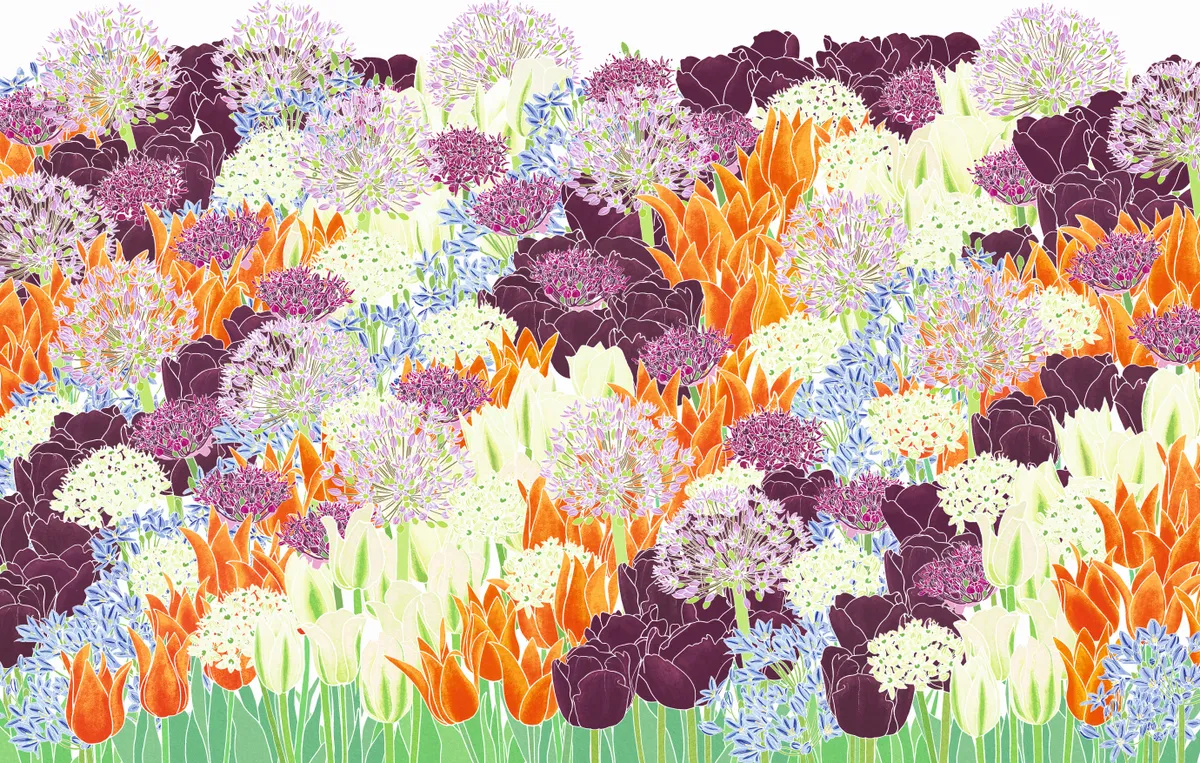To begin we must cast our minds back to the cold winds and icy rains of January when everything in the garden is pretty miserable. Herbaceous plants are just wind-whipped handfuls of decaying stems. Sure, evergreens are reliably green but we are hankering for a splash of colour. The first sign of this will always be bulbs: small, low-growing, weather-resistant bulbs. Although the charming illustration that accompanies this article concentrates on the later, more spectacular bulbs, there is a whole prequel of flowers that unravels during the first quarter of the year.
The first bulb to poke her head from the cold brown earth will be Iris ‘Katharine Hodgkin’. This one is a rather delicate pale blue with petals as finely veined as a bat’s wing – but there are other bulbs in more robust colours, in particular Iris ‘Purple Gem’ or Iris ‘Edward’. She is swiftly joined by the crocus, in this imaginary case Crocus sieberi ‘Albus’ (also known as ‘Bowles’ White’) and Crocus chrysanthus ‘Prins Claus’ (which has a maiden’s blush of purple on each petal). Finally, Tulipa turkestanica, which is a little species tulip of enormous charm and robustness. All these early bulbs are little things but well worth the effort.
Plant them a few inches deep in the autumn – I have a pointed iron bar with which I vigorously stab the ground when planting small bulbs like this: bulb in hole and then a dusting of topsoil to seal the wounds. The secret is in making the spread as random as possible. You will notice that most of this first tranche of bulbs are in very pale colours: a slow and gentle beginning to the year. When it gets to April we need a bit of oomph.
Click the link to download a PDF of the border plan

How to create your bulb border
Buy in bulk
Allium altissimum
Allium atropurpureum
Allium nigrum
Crocus chrysanthus ‘Prins Claus’
Crocus sieberi ‘Albus’ (also known as ‘Bowles’ White’)
Iris ‘Katharine Hodgkin’
Triteleia 'Ocean Queen'
Tulipa 'Ballerina'
Tulipa 'Paul Scherer'
Tulipa turkestanica
Tulipa 'Spring Green'
I have known people who bought ten tulips at a time. Big mistake. Ten will barely fill a small pot. Tulips should always be planted en masse: you need to think in hundreds. The tulip is the fanfare that greets the beginning of summer and, as such, should be loud and unashamed. In this border I have put three cultivars that stampede in blocks across the bed and these, although usually flowering at slightly different times, will overlap and provide a spectacle for about six weeks. There are so many fabulous tulips that it’s tricky to choose from the scores of different combinations that will work well together. In this case the juxtaposition of deep purple Tulipa ‘Paul Scherer’, vibrant orange (and scented) Tulipa ‘Ballerina’ and the cool, soothing Tulipa ‘Spring Green’ gives just the right touch of restrained glamour. Three kinds are probably enough: more colours and it begins to look you’ve had a horrible accident with the fruit salad.
Chirpy alliums
As the tulips begin to fade away, the alliums take over: they are a bit like caricature hockey teachers in a girls’ school, robust and irrepressibly perky, no matter what the weather. I have chosen three sorts of alliums, which I would plant in lines running across the banks of tulips. Firstly, Allium altissimum, which has to be about the tallest of the lot: its sturdy stems are about 1.5m high and support flower spheres 10cm in diameter. If you have trouble finding a supplier, Allium ‘Gladiator’ is fine as an alternative. Beneath them will be plummy red Allium atropurpureum and Allium nigrum, which is white with a greenish tinge.
Alliums die beautifully, which is always an advantage: their flowers fade to skeletal husks dotted with seeds as black and shiny as the eyes of a field mouse. As they lose their lustre, the last bulb in the scheme flares into life: Triteleia ‘Ocean Queen’ is about 30cm high with great clusters of sky-blue flowers that carry on until mid-July.
All bulbs need good soil if they are to thrive – especially tulips, which have an annoying habit of dying after the first year in heavy clay – so when choosing a site for your border, avoid anywhere shady or dry. The secret is not to crowd the bulbs, so each flower has a chance to shine. About ten tulips per square foot is usually plenty, but T. turkestanica is quite small, so 15 is better. Plant the crocus and iris about 20 per square foot. Alliums must be far enough apart not to bump into each other, so their planting is less dense: two A. altissimum, and five A. nigrum or A. atropurpureum, per square foot is enough.
This is designed to be a spectacular border awash with colour and bold geometry, but I think we all realise that it is also a delicious and entrancing fantasy. Few people will ever plant a border solely composed of bulbs, as for the majority of the year it will be naked and uninteresting: a real border needs the depth of shrubs, the romance of roses and a whole raft of herbaceous plants. However, the idea is alluring, and it is possible to keep a border occupied for the first half of the year. Thereafter, I suppose, we could always rely on the unquenchable effulgence of annuals.
